13 Best AI Agent Builders to Automate Workflows in 2025

Sorry, there were no results found for “”
Sorry, there were no results found for “”
Sorry, there were no results found for “”

⏩ Fact Check: A McKinsey report found that nearly 30% of working hours across industries could be automated with AI.
That’s not a warning—it’s an opportunity.
Imagine sales handoffs that happen automatically, reports that build themselves, and onboarding checklists that complete before you even ask.
AI isn’t just speeding up work anymore—it’s starting to do the work.
With no-code and low-code AI agent builders, you can create digital teammates that think, decide, and act across your tools—no coding required.
In this guide, we’ve rounded up the most powerful AI agent builders you can use right now to save time, cut manual effort, and focus on the big stuff.
Let’s meet your future team of tireless digital collaborators.
Some AI agents automate the basics. Others help you coordinate work across tools. The best ones feel like they were built for your team from the start.
Here’s what matters when choosing one 👇
👀 Did You Know? The first AI agent, Logic Theorist (1956), was designed by Newell, Shaw, and Simon to prove mathematical theorems.
It mimicked human reasoning and even discovered a more efficient proof than one in Principia Mathematica.
Here’s a quick snapshot of the best tools to build intelligent AI agents without writing code.
| Tool | Best for | Best features | Pricing |
|---|---|---|---|
| ClickUp | Internal productivity and context-aware task agents Team size: Ideal for startups, cross-functional teams, and enterprises | Autopilot Agents, ClickUp Brain, native automations, multi-model AI, embedded workflows | Free forever; Customizations available for enterprises |
| Crew AI | Role-based, multi-agent orchestration Team size: Ideal for research, planning, and analysis workflows | Agent roles (e.g., researcher, planner), sequential/concurrent flows, vector memory | Free; Paid plans from $25/month |
| UiPath | Enterprise-grade RPA + AI agent automation Team size: Ideal for IT, finance, and customer service teams | Agent Builder, Orchestrator, human-in-loop, AI Center integrations | Paid plans from $25/month |
| Postman AI Agent Builder | Visual API-connected AI workflows Team size: Ideal for product, API, and DevOps teams | Drag-and-drop flows, multi-LLM testing, 18K+ API integrations | Custom pricing |
| Vertex AI Agent Builder | Enterprise agents within Google Cloud ecosystem Team size: Ideal for data teams and enterprise devs using GCP | Agent Dev Kit, prebuilt connectors, serverless agent engine | Custom pricing |
| Zapier AI Agents | Natural language-driven automation Team size: Ideal for operations, marketing, and SMBs | 6K+ integrations, multi-step AI agents, internal API access | Free plan; Paid plans from $29.99/month |
| LangChain | Modular, developer-friendly agent framework Team size: Ideal for AI engineers building custom logic | Tool chaining, LangGraph orchestration, 50+ integrations | Free (Pay-as-you-go); Plus from $39/month |
| Botpress | Multilingual conversational AI agents Team size: Ideal for CX and automation teams | Visual flow editor, NLU/NLP engine, self-hosting, API/database access | Free (Pay-as-you-go); Plus from $89/month |
| Haystack | Retrieval-augmented generation (RAG) pipelines Team size: Ideal for AI research and enterprise search teams | Modular agents, ToolInvoker, multi-retriever support, observability | Free (open source) |
| AutoGen | Python-based multi-agent collaboration Team size: Ideal for technical teams automating research or dev workflows | UserProxy pattern, Assistant+Critic loops, model-agnostic config | Free (open source) |
| Voiceflow | Voice/chat AI agent design and deployment Team size: Ideal for product, support, and CX teams | Visual agent builder, multimodal interface, Dialog API export | Free plan; Paid plans from $60/month |
| Microsoft Copilot | Microsoft 365-integrated AI agents Team size: Ideal for enterprise productivity and IT operations | Copilot Studio, natural language agent builder, Microsoft Graph | Starts at $20/user/month |
| Relevance AI | No-code AI agent workforces for ops teams Team size: Ideal for sales, marketing, and back-office automation | Drag-drop builder, vector store, prebuilt agents (AI BDR, etc.) | Free; Paid plans from $19/month |
Our editorial team follows a transparent, research-backed, and vendor-neutral process, so you can trust that our recommendations are based on real product value.
Here’s a detailed rundown of how we review software at ClickUp.
AI is changing how we get things done, and a new wave of platforms now makes it easier for teams to build their own smart, autonomous agents.
Here are some of the best AI agent builders leading the change 👇
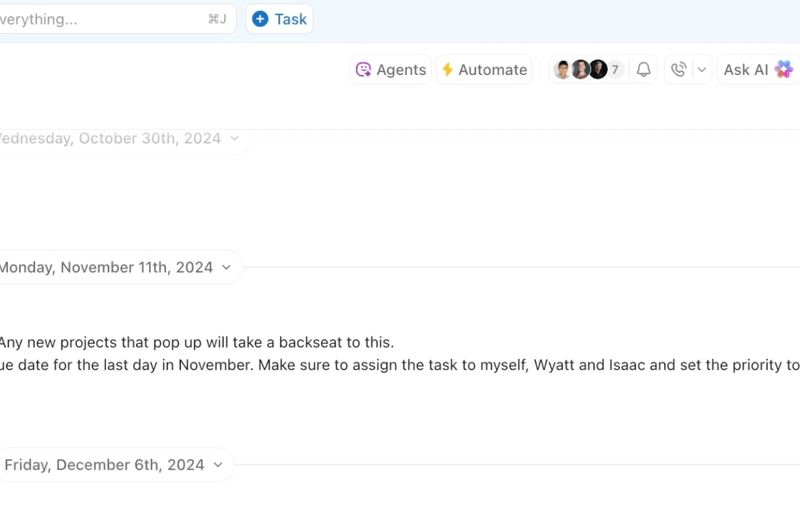
ClickUp, the everything app for work, empowers teams to build AI agents directly inside their workspace.
ClickUp Autopilot Agents allow you to build customized AI agents that make decisions based on context.

For example, when someone posts a message in Slack or submits a form, the agent can analyze that input, check task conditions, and assign the right next step. You can set up instructions, feed in workspace knowledge, and use native tools like Docs, Tasks, and Comments to make the agent feel like part of your team.
⚡ Quick Hack: Build a custom AI agent in ClickUp:
Tied closely with this is ClickUp Brain, which brings AI into the center of your workflow. It connects to your actual work—tasks, docs, and comments—and helps generate task summaries, draft emails, or break down large projects into subtasks.

For routine work, ClickUp Automations allows you to set up automated rules to handle repetitive actions, such as assigning owners, setting due dates, or updating statuses.
But you’re not limited to status changes or field updates. ClickUp supports webhooks, custom actions, and task creation triggers, which means you can pipe ClickUp events into external systems or trigger Autopilot Agents directly.
For example, a form submission can create a task, which triggers an Autopilot Agent to automatically summarize the request, tag the urgency, and suggest an assignee.
As Automations run natively inside ClickUp, there’s no lag or dependency on third-party connectors. You control execution timing, scope (Folder/List/Space), and output.
If your team is tired of duct-taping together separate tools for tasks, documents, chat, and AI, ClickUp gives you one place to build, manage, and automate it all, with agents that understand your work.
A Capterra review says,
What I like best about ClickUp is its customization and flexibility. Whether it’s creating tailored workflows for different teams (like marketing and web development), using custom fields to track specific project details, or automating repetitive tasks, ClickUp allows me to adapt it to our exact needs. It helps keep everything in one place, making project management and communication seamless across teams. Plus, the integrations and automations save us so much time, allowing us to focus on what truly matters.

Crew AI lets you go beyond one-off agents and build autonomous teams of AI agents that can collaborate in real time. Each agent is assigned a role (like ‘researcher,’ ‘planner,’ or ‘reviewer’) and a set of tools or skills, enabling them to work together toward a shared goal.
It is a multi-agent AI agent platform, a Python framework. It is suitable for orchestrating multi-step workflows, such as report generation, product research, or marketing campaign planning, where coordination between specialized agents is crucial.
This type of AI agent is collaborative and goal-driven, designed to handle complex workflows through structured role assignment and coordination.
👀 Did You Know? In 2017, Sophia, the humanoid robot created by Hanson Robotics, became a citizen of Saudi Arabia—the first robot to receive citizenship.
Building AI agents is one thing—using them effectively is another.
🎥 In this video, you’ll see how to use AI as a personal assistant to manage schedules, draft messages, and handle routine tasks—showing exactly what great agent builders make possible.
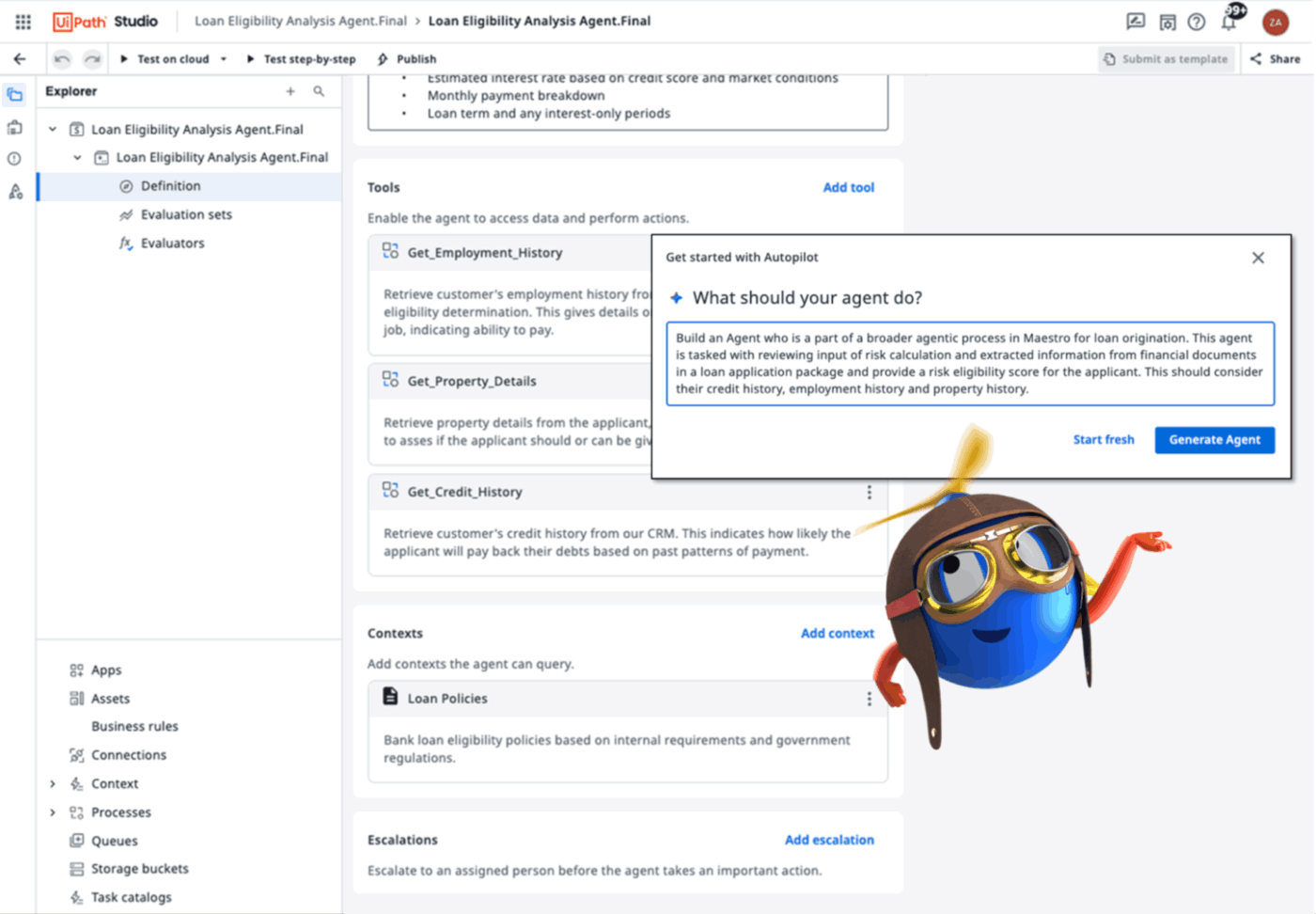
UiPath combines robotic process automation (RPA) with its new agentic AI capabilities. With UiPath Agent Builder, businesses can create low-code AI agents trained to handle context-aware, end-to-end processes, like invoice handling and customer interactions.
It’s designed for building AI agents that are both scalable and compliant. Backed by UiPath Orchestrator and built-in security, it bridges deterministic automation with decision-making AI, suitable for custom AI agents in enterprise workflows.
A G2 review says,
The UiPath Platform offers a user-friendly interface, drag-and-drop workflow design, and excellent integration capabilities with enterprise applications. It speeds up automation development and enables quick deployment with reusable components. Its Orchestrator provides robust control and monitoring for RPA processes, and the AI Center opens doors for intelligent automation.
📚 Read More: Workflow Automation Examples and Use Cases
With the Postman AI Agent Builder, teams can create custom AI agents that call APIs, reason through complex workflows, and handle real-time logic without writing a line of code.
Built on top of Postman Flows, the AI Agent Builder lets you connect large language models to APIs using drag-and-drop blocks, add memory, set conditions, and debug agent template output, within the same interface.
📮 ClickUp Insight: Only 10% of our survey respondents use voice assistants (4%) or automated agents (6%) for AI applications, while 62% prefer conversational AI tools like ChatGPT and Claude.
The lower adoption of assistants and agents could be because these tools are often optimized for specific tasks, like hands-free operation or specific workflows.
ClickUp brings you the best of both worlds. ClickUp Brain serves as a conversational AI assistant that can help you with a wide range of use cases. On the other hand, AI-powered agents within ClickUp Chat channels can answer questions, triage issues, or even handle specific tasks!
Vertex AI Agent Builder helps you build smart AI agents that can talk to each other, pull in company data, and complete tasks together, all within the Google ecosystem.
You get an easy Agent Development Kit (ADK) to define agent behavior in simple Python, support for open standards like Agent2Agent (so agents built with different tools can still collaborate), and pre-built connectors to bring in data from internal systems.
A Capterra review says,
The best thing about Vertex AI is its out-of-the-box AutoML functionality with low-code, scalable, and efficient infrastructure. Plugin and unified platform capabilities help with integrations, calibrations, and results monitoring.
🧠 Fun Fact: In China’s first-ever humanoid robot soccer tournament, one robot “player” was carried off the field on a stretcher after a collision—yes, a stretcher… for a robot! The fully autonomous match was full of tumbles, injuries, and AI-driven action!
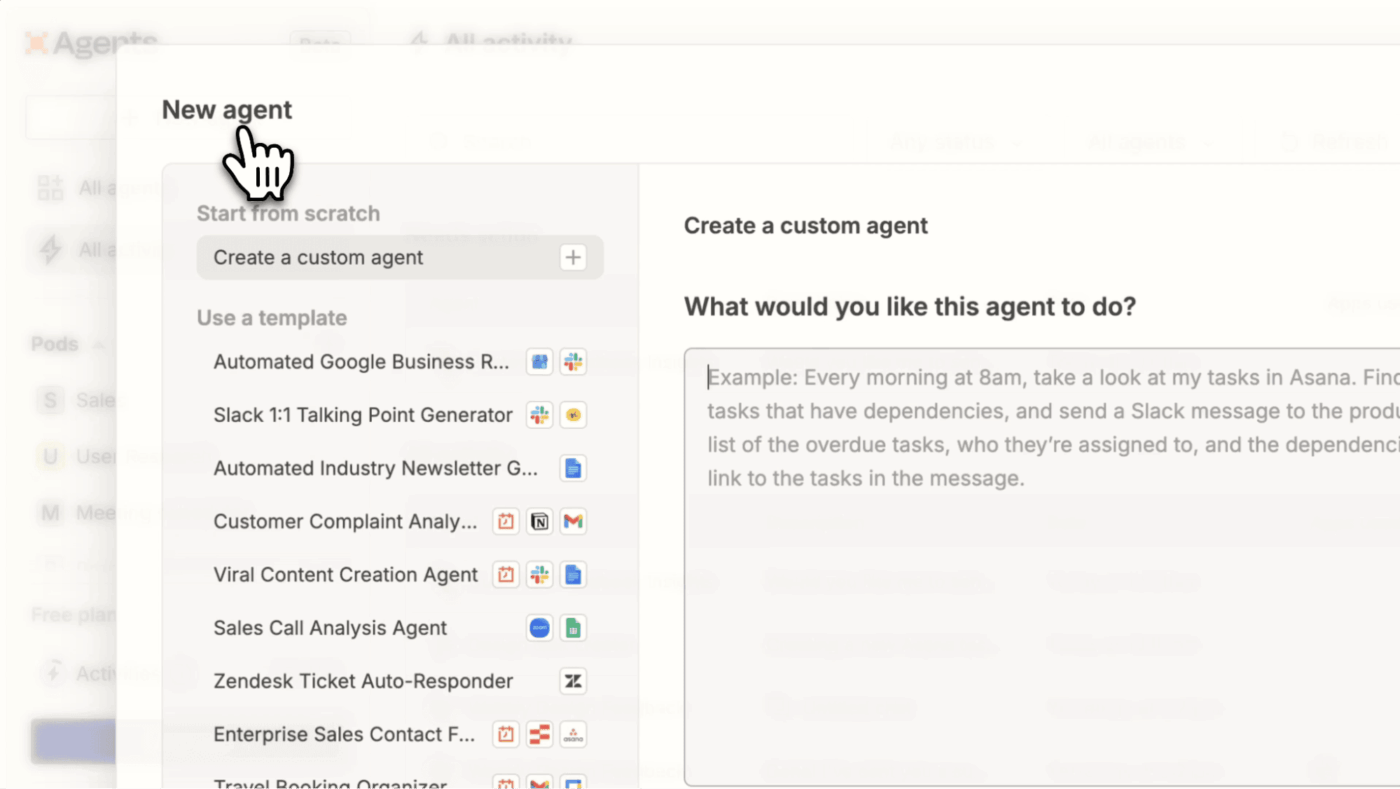
Zapier AI Agents takes traditional Zaps and supercharges them with natural language automation.
Instead of creating individual automations manually, you can now describe what you want in plain English, like ‘create a task in Asana when a lead fills out a form,’ and the AI will build the automation for you. These AI agents for business can also reason through logic, call APIs, and hand off tasks to other tools in your stack.
A G2 review says,
I really like how easy Zapier is to use and how simple it is to show others how to build with it. I mostly use it for automations, but I’m planning to explore the AI Agents and Tables features when I get some time. What I love most is how many apps it connects to. Even the rare ones usually have triggers, which is super cool. Some people say Zapier is expensive, but I think if you use their built-in tools the right way, it’s actually pretty good value and really easy to set up. Finally for the few times I had to connect with their customer support, they are awesome and genuinely helpful!
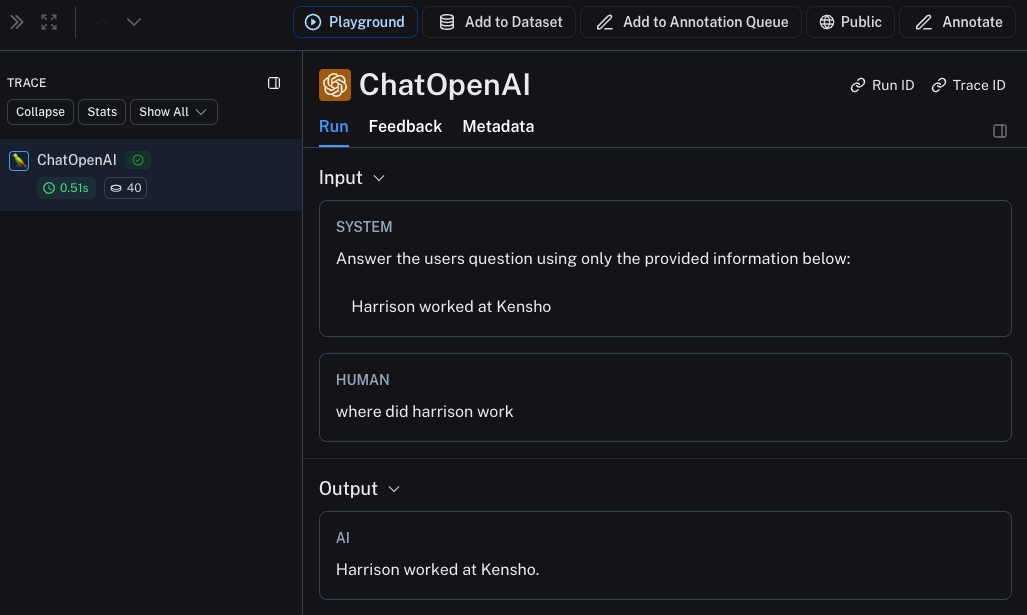
Unlike a traditional chatbot that responds within fixed parameters, an AI agent built with LangChain can plan, reason, and take multi-step actions, making it context-aware. It uses an open-source framework.
You can also stack components (Chains, Agents, Memory, Tools) to create multi-step assistants that think, act, and iterate. The modular design enables AI agents to access external tools, APIs, or files to complete more advanced tasks. Developers can also customize AI agents to follow specific logic, workflows, or decision-making paths that fit unique use cases.
A G2 review says,
It is one of the best packages required to use Large Language Models in the field of Generative AI, it is easy to adapt and works like a charm and it keeps upgrading itself to be compatible with the latest technology.
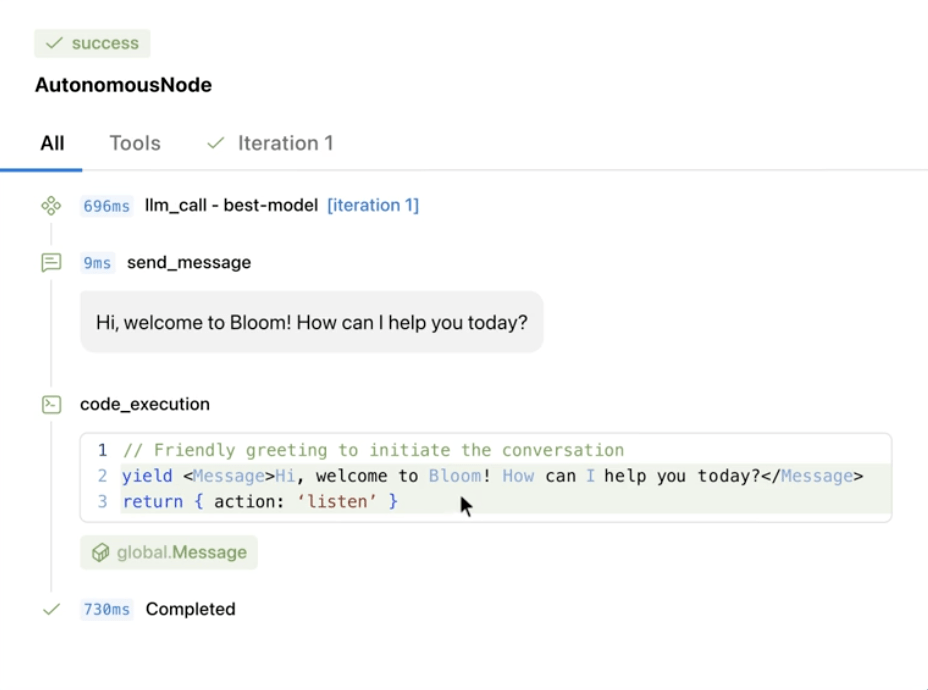
Botpress is an open-source conversational AI platform built for developers who want complete control over how their agents are designed, deployed, and localized.
It combines natural language understanding (NLU) with a visual conversation studio, allowing you to manage logic, intents, and actions without writing extensive code. You can deploy agents across various channels, such as WhatsApp, Messenger, or custom UIs, and customize every aspect of the interaction logic.
A Capterra review says,
I like that Botpress is versatile in its functionality. It comes with great built-in tools as well as the possibility to embed custom code.
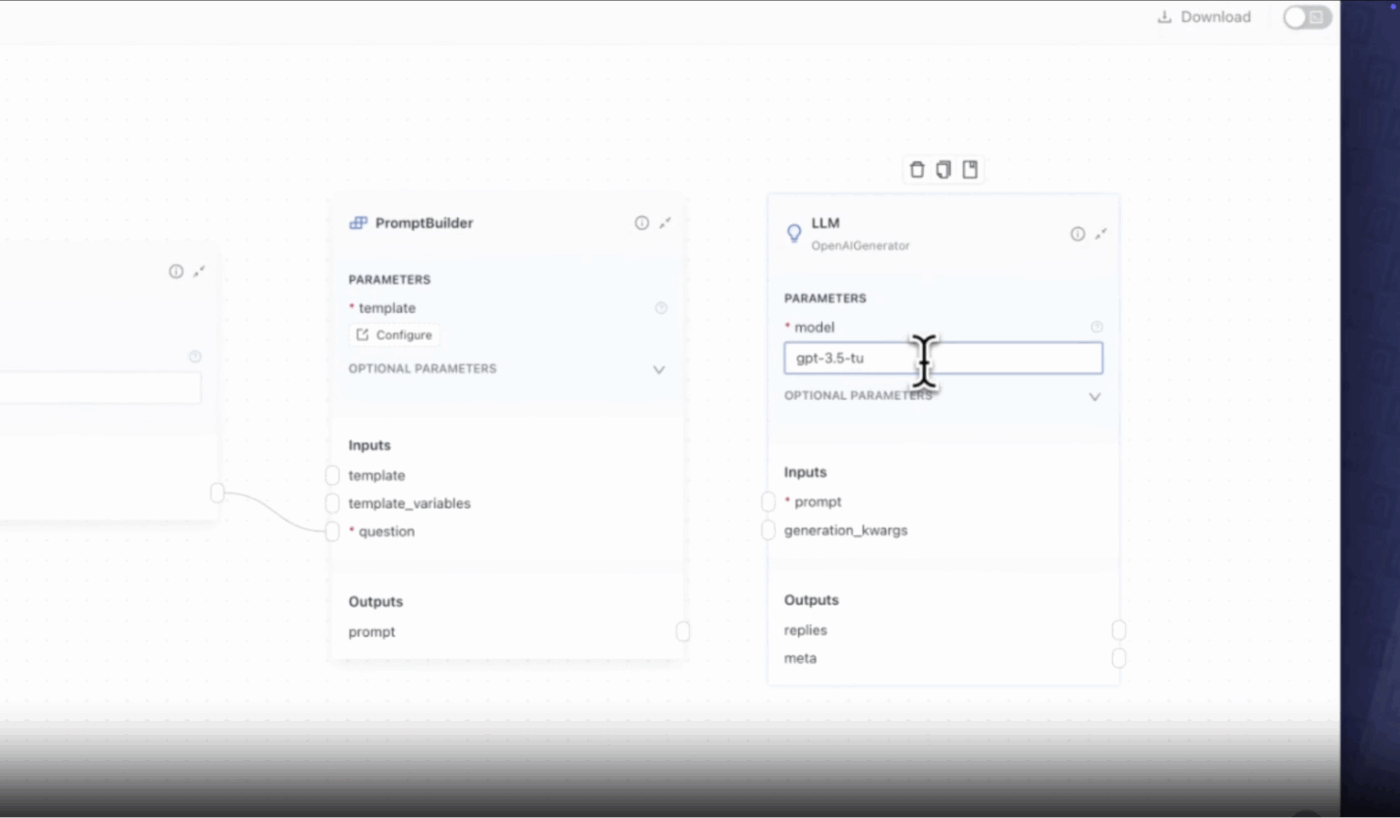
Haystack, from Deepset, is an open-source AI orchestration framework built for developers to craft production-ready LLM agents. It is suitable for creating complex retrieval-augmented generation (RAG) pipelines, search systems, and multi-step agentic workflows.
With modular components (retrievers, generators, and tools), JSON schema validation, parallel tool execution, and built-in monitoring, Haystack helps design, test, deploy, and scale intelligent applications across cloud and on-premises environments.
A G2 review says,
Haystack is a powerful open-source Python framework for building natural language processing (NLP) pipelines. It offers a range of pre-built components for common NLP tasks, as well as support for various pre-trained language models and deep learning frameworks. This makes it easy to build and deploy sophisticated NLP applications, such as chatbots, document search engines, or question-answering systems.
🧠 Fun Fact: The term ‘artificial intelligence’ was coined in 1956 during the famous Dartmouth Workshop by John McCarthy, Marvin Minsky, and others, often seen as the official birth of AI as a field.
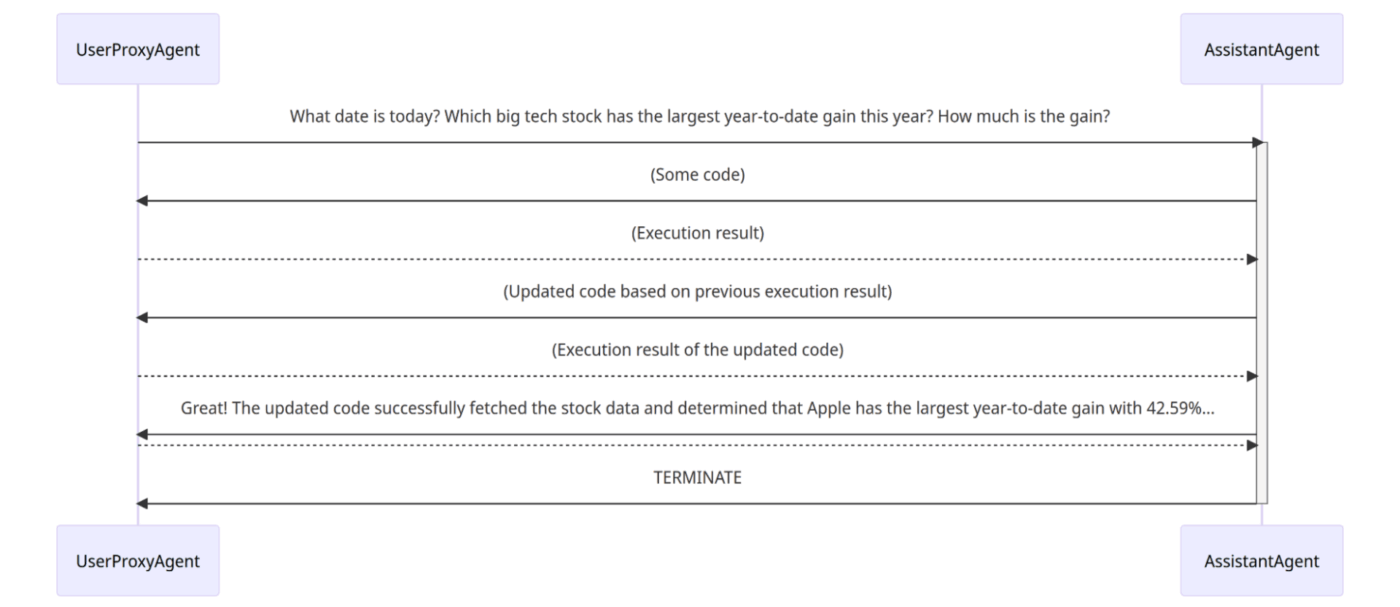
Created by Microsoft Research, AutoGen helps build conversational agent systems that operate on natural language instructions.
A typical setup pairs a ‘UserProxy’ agent (which holds the goal and reviews results) with multiple ChatCompletion or Assistant agents (researcher, coder, critic). They converse through an event loop until the UserProxy decides the job is done, giving you a pattern to automate research reports, data analysis, or iterative coding sessions.
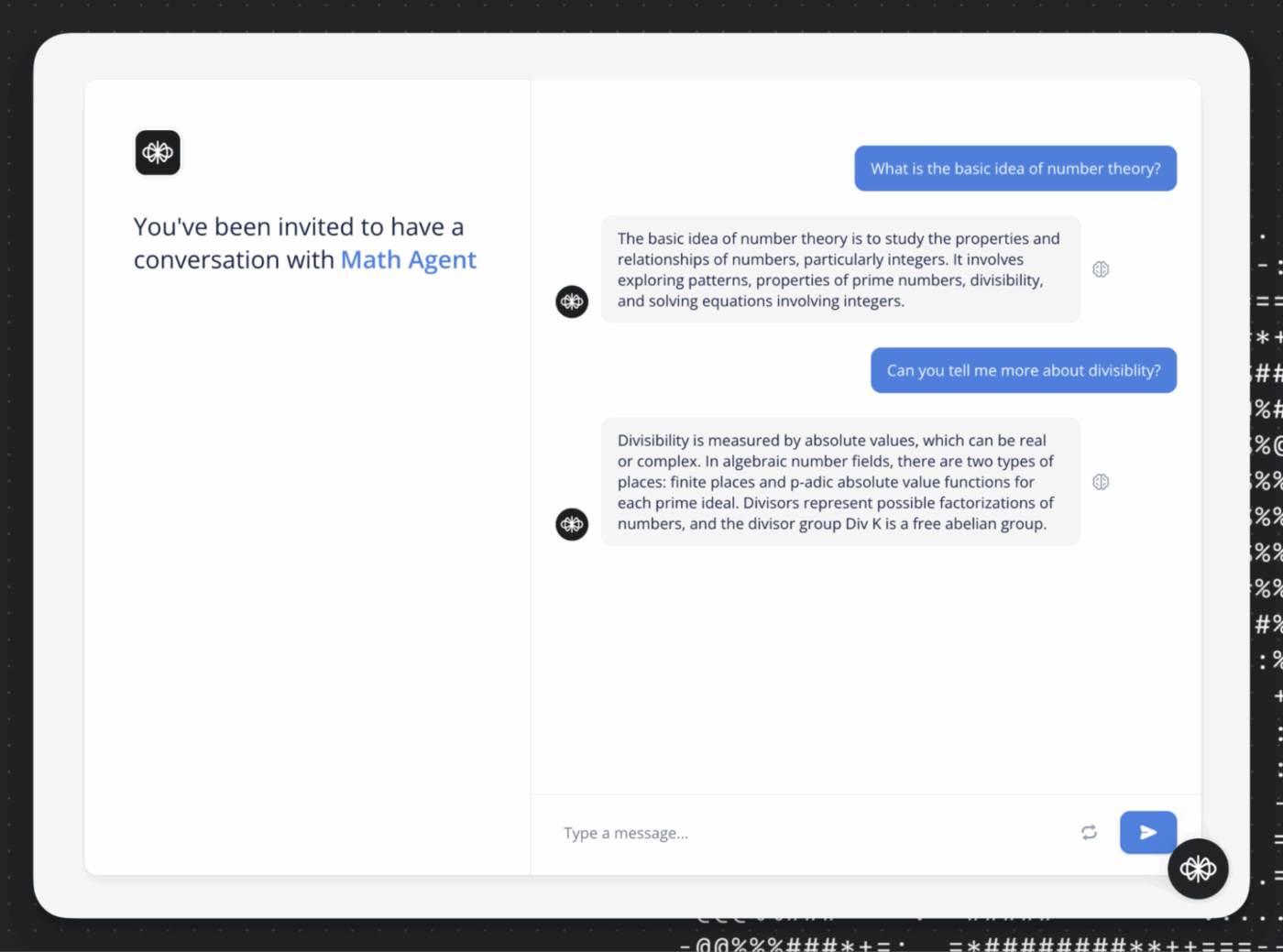
Voiceflow is a conversational AI tool builder that lets teams design and launch voice or chat agents using a visual, no-code interface.
It supports multimodal interfaces (voice, text, buttons, visuals), real-time prototyping, and easy handoffs to engineering. It’s a centralized hub for cross-functional teams to co-create dynamic assistants across platforms like Alexa, Google Assistant, websites, and messaging apps.
A G2 review says,
Ease of use, friendly user face, many people using it and the voiceflow community makes it extremely easy to get support when stuck on something. I personally use it everyday and I’ve built tons of agents already, and would honestly recommend it to everybody. To implement all it takes is just a piece of code from settings and done. [sic]
Microsoft Copilot combines the power of GPT‑4‑based AI with native integration across Microsoft 365.
With Copilot Studio, your team can build AI agents for productivity using simple natural language prompts or drag‑and‑drop tools, then deploy them in Teams chats, SharePoint, Outlook, and Word to automate tasks, answer questions, or streamline operations.
A Reddit review says,
We use it internally. It’s like your own company search engine. You can ask it for documents or even to lookup information out of the documentation. It is also good at summarizing conversations and emails. I can ask it to summarize all of the emails that I got in the last 24 hours and it does a good job of telling me the important stuff.
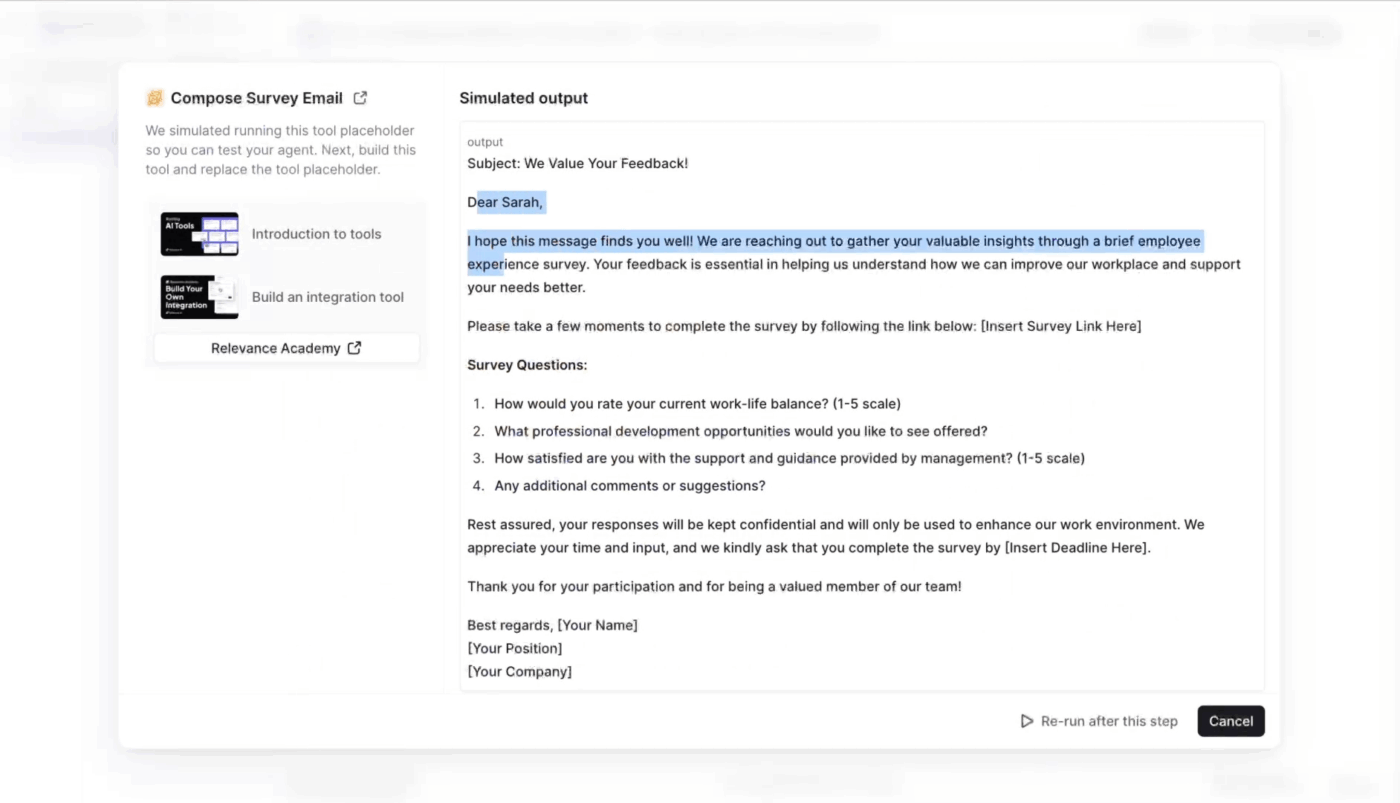
Relevance AI is a no-code platform built for ops teams, startups, and developers who want to deploy ‘AI co-workers.’ The AI agent can automate multi-step workflows across sales, marketing, support, and back-office ops.
Agents can be trained on internal processes using uploaded files or URLs and are deployed visually through a drag-and-drop interface. With plug-and-play integrations with CRMs, email, Slack, and more, it’s built for production-grade automation, fast.
A G2 review says,
I really appreciate how flexible Relevance AI is and how you can add custom python code to your agent. It’s also easy to integrate with other tools.
AI agents are already talking to customers on your behalf, surfacing insights, automating data entry, and even orchestrating entire workflows. Tasks that were previously handled by large teams.
At the center of this shift is ClickUp. It’s not just a project management tool anymore. With Autopilot Agents, ClickUp Brain, and natural language automations, it gives you everything you need to turn tasks into actions and ideas into execution.
You’re no longer managing work. You’re designing a system that does it for you.
Sign up on ClickUp and create your first intelligent agent today.
© 2025 ClickUp